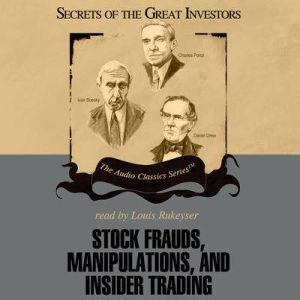
List: $11.95
| Sale: $8.36
Club: $5.97
Stock Frauds, Manipulations, and Insider Trading
Narrator: Louis Rukeyser
Unabridged: 2 hr 55 min
Format: Digital Audiobook Download
Publisher: Knowledge Products, Inc.
Published: 03/06/2006
Category: Business & Economics
Synopsis
An early form of stock fraud was watering, where more shares were issued and sold that were authorized by the company (thus diluting the value of all shares) In a corner, traders sought to control so much of a stock that short sellers (who had borrowed shares and sold the with the expectation of buying back later at lower prices) were forced to buy shares they owed from the manipulator, on his terms. Famous corners included First Harlem Railroad and the famous Erie raids. The Ponzi scheme (or pyramid scheme) perfected by Charles Ponzi in the 1920s, is the investment equivalent of a chain letter, with returns for early investors, until all collapses when new investment runs dry. After the 1929 stock market crash, the securities reform of the 1930s curbed many types of fraud and manipulation. Insider trading is a longstanding issue in securities markets. The issue essentially is how fair and equitable trading can be maintained despite great differences among traders in their knowledge of a companys affairs. After the Securities Act of 1933 created the Securities and Exchange Commission, and the Securities Exchange Act of 1934 gave the commission powers, a 1942 rule known as Rule 10b5 established guidelines for stock purchases by major market players or insiders. A series of Supreme Court cases in the 1950s and 60s elaborated the laws on insider trading, and scandals of the 1980s led to still further attempts at reform. Analysis of stock trades by company officials (insiders) remains a poplar type of analysis that guides many purchases of stock.